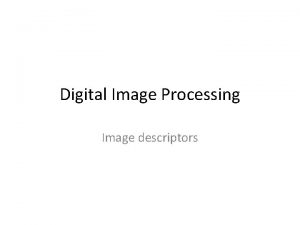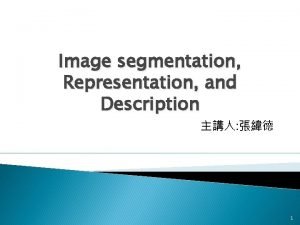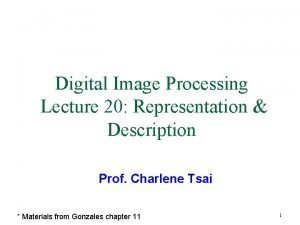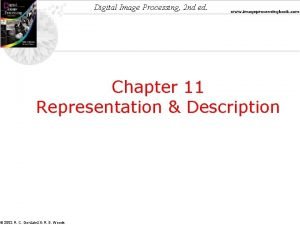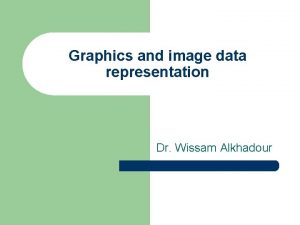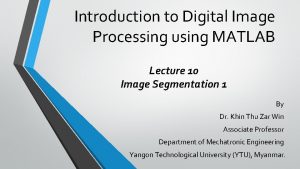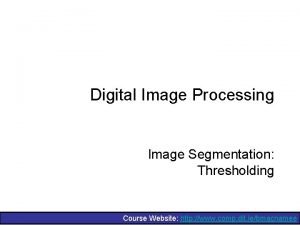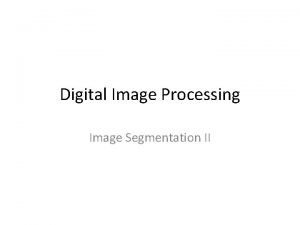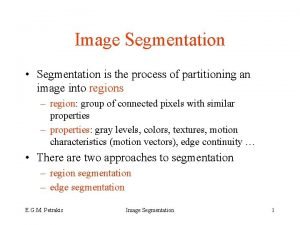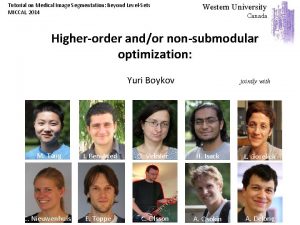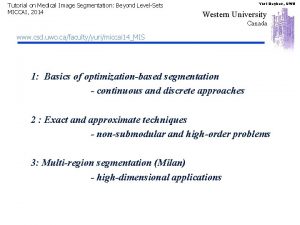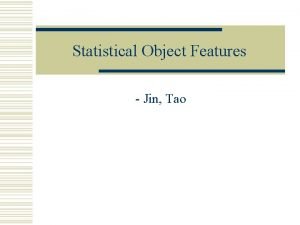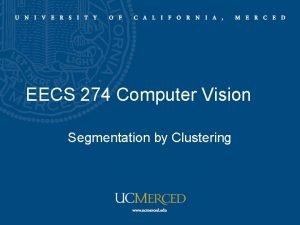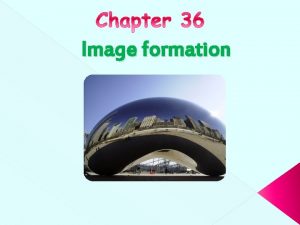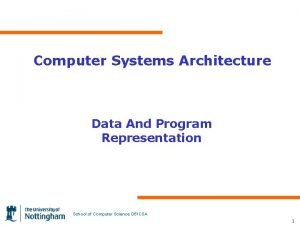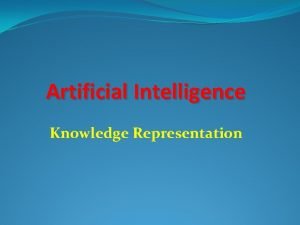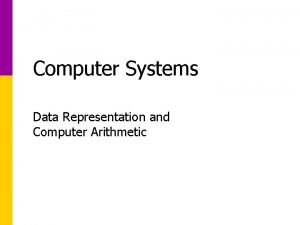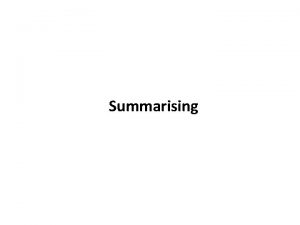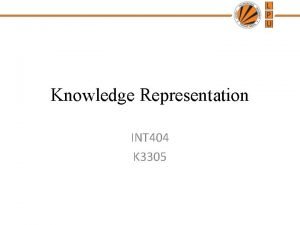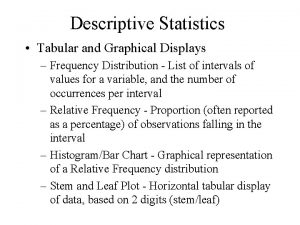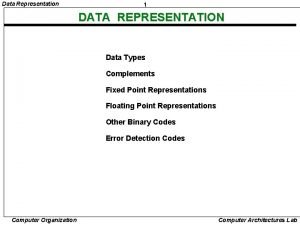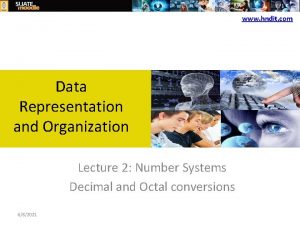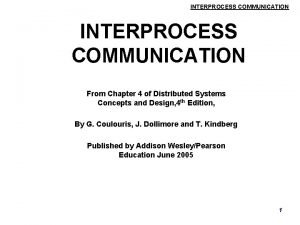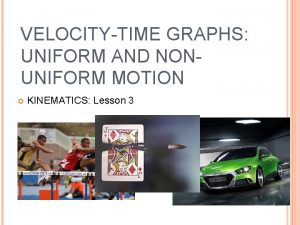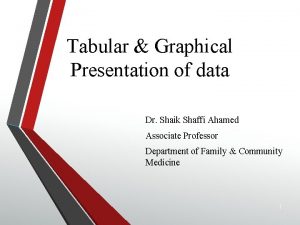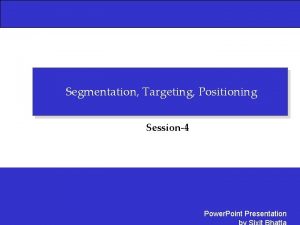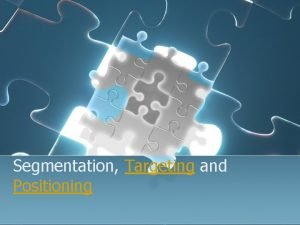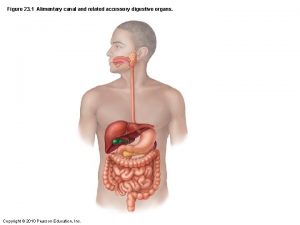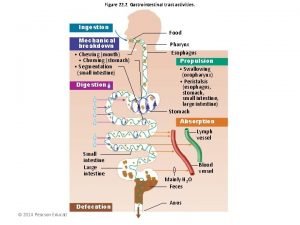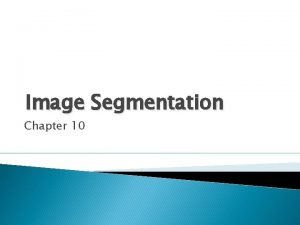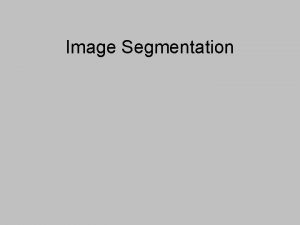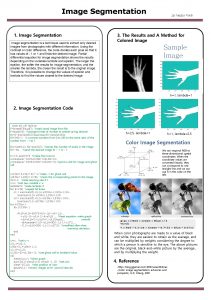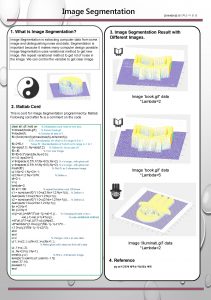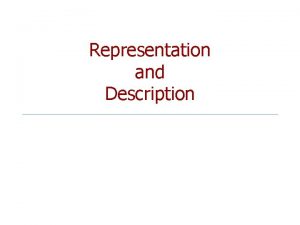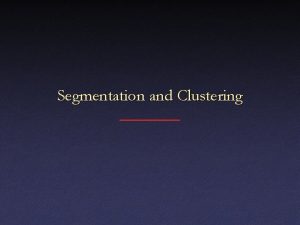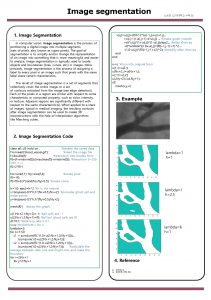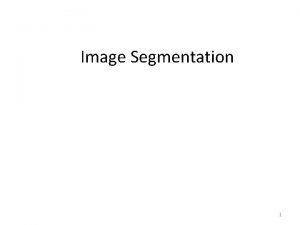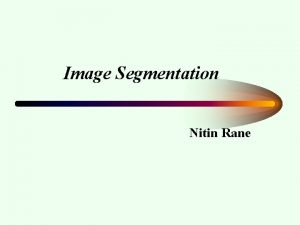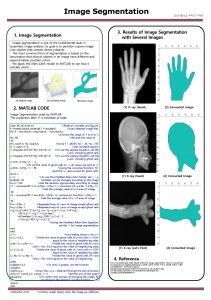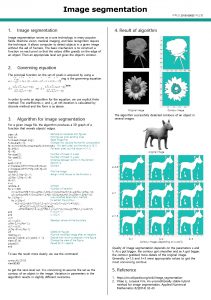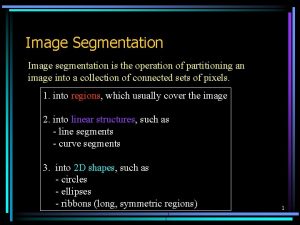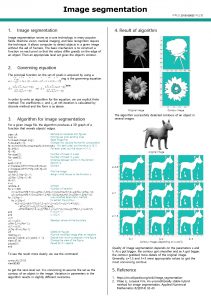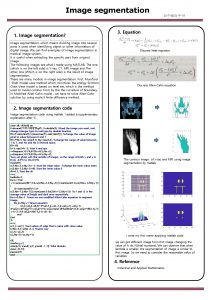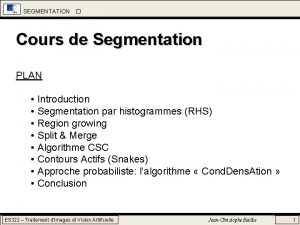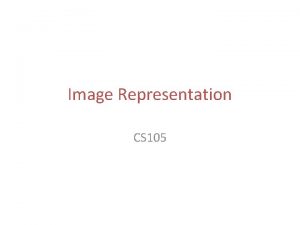Image segmentation Representation and Description 1 OUTLINE Image






































![Reference � [1] R. C. Gonzalez, R. E. Woods, Digital Image Processing second edition, Reference � [1] R. C. Gonzalez, R. E. Woods, Digital Image Processing second edition,](https://slidetodoc.com/presentation_image_h/ec56295faecb924290637b55692b4885/image-39.jpg)

- Slides: 40

Image segmentation, Representation, and Description 主講人: 張緯德 1

OUTLINE � Image segmentation � Image representation � Image description ◦ ex: edge-based, region-based ◦ ex: Chain code , polygonal approximation signatures, skeletons ◦ ex: boundary-based, regional-based � Conclusion 2

Image segmentation edge-based: point, line, edge detection 3

edge-based segmentation(1) � There are three basic types of gray-level discontinuities in a digital image: points, lines, and edges � The most common way to look for discontinuities is to run a mask through the image. � We say that a point, line, and edge has been detected at the location on which the mask is centered if , where 4

edge-based segmentation(2) � Point detection a point detection mask � Line detection a line detection mask 5

edge-based segmentation(3) � Edge detection: Gradient operation 6

edge-based segmentation(4) � Edge detection: Laplacian operation 7

Image segmentation Region-base: SRG, USRG, Fast scanning 8

region-based segmentation SRG(1) � Region growing: Groups pixels or sub-region into larger regions. ◦ step 1: �Start with a set of “seed” points and from these grow regions by appending to each seed those neighboring pixels that have properties similar to the seed. ◦ step 2: �Region splitting and merging 9

region-based segmentation SRG(2) � Advantage: ◦ With good connectivity � Disadvantage: ◦ Initial seed-points: �different sets of initial seed-point cause different segmented result ◦ Time-consuming problem 10

region-based segmentation USRG(1) � Unseeded region growing: ◦ no explicit seed selection is necessary, the seeds can be generated by the segmentation procedure automatically. ◦ It is similar to SRG except the choice of seed point 11

region-based segmentation USRG(2) � Advantage: ◦ easy to use ◦ can readily incorporate high level knowledge of the image composition through region threshold � Disadvantage: ◦ slow speed 12

region-based segmentation fast scanning(1) � Fast scanning Algorithm: ◦ The fast scanning algorithm somewhat resembles unseeded region growing ◦ the number of clusters of both two algorithm would not be decided before image passing through them. 13

region-based segmentation fast scanning(2) 14

region-based segmentation fast scanning(3) � Last step: ◦ merge small region to big region 15

region-based segmentation fast scanning(4) � Advantage: ◦ The speed is very fast ◦ The result of segmentation will be intact with good connectivity � Disadvantage: ◦ The matching of physical object is not good �It can be improved by morphology and geometric mathematic 16

region-based segmentation fast scanning-improved by morphology � dilation � erosion 17

region-based segmentation fast scanning-improved by morphology � dilation � erosion 18

region-based segmentation fast scanning-improved by morphology � opening Erosion=>Dilation � closing Dilation=>Erosion 19

region-based segmentation fast scanning-improved by Geometric Mathematic 20

region-based segmentation fast scanning-improved by Geometric Mathematic 21

region-based segmentation application � Muscle Injury Determination � � How to judge for using image segmentation? Use fast scanning algorithm to segment it. 22

Representation chain code, polynomial approximation, signature, skeletons 23

Representation chain code 4 -direction 8 -direction 24

Representation polynomial approximations � Merging Techniques � Splitting Techniques 25

Representation signature Distance signature of circle shapes Distance signature of rectangular shapes 26

� Step 1: ◦ ◦ Representation skeletons (a) (b) (c) (d) � Step 2: ◦ (c’) ◦ (d’) 27

Descriptors boundary descriptor: Fourier descriptor, polynomial approximation 28

Boundary Descriptors Fourier descriptors (1) � Step 1: � Step 2: (DFT) � Step 3: (reconstruction) if a(u)=0 for u>P-1 � Disadvantage: ◦ Just for closed boundaries 29

� What’s Boundary Descriptors Fourier descriptors (2) the reason that previous Fourier descriptors can’t be used for non-closed boundaries? � How can we use the method to descript non -closed boundaries? (a)linear offset (b)odd-symmetric extension s 1(k) (x. K 1, y. K 1) (x 0, y 0) s 2(k) Step 2 • Original segment (b) Linear offset s 3(k) Step 3 (c) Odd symmetric extension 30

� The Boundary Descriptors Fourier descriptors (3) proposed method is used not only for non-closed boundaries but also for closed boundaries. � Why we used proposed method to descript closed boundaries rather than previous method? 31

Boundary Descriptors polynomial approximation(1) � Lagrange Polynomial � Cubic Spline Interpolation 32

Boundary Descriptors polynomial approximation(2) � Proposed method(1) ◦ Step 1: rotate the boundary and let two end point locate at x-axis ◦ Step 2: use second order polynomial to approximate the boundary 33

Boundary Descriptors polynomial approximation(3) � Proposed method(2) ◦ If the boundary is closed, how can we do? ◦ Step 1: use split approach divide the boundary to two parts. ◦ Step 2: use parabolic function to fit the boundary. 34

Descriptors Regional descriptors: Topological, Texture 35

�E Regional Descriptors Topological =V-Q+F=C–H ◦ E: Euler number V: the number of vertices Q: the number of edges F: the number of faces C: the number of connected component ◦ H: the number of holes ◦ ◦ 36

Regional Descriptors Texture � Statistical approaches ◦ smooth, coarse, regular � nth moment: ◦ 2 th moment: � is a measure of gray level contrast(relative smoothness) ◦ 3 th moment: � is a measure of the skewness of the histogram ◦ 4 th moment: � is a measure of its relative flatness ◦ 5 th and higher moments: � are not so easily related to histogram shape 37

Conclusion � Image segmentation ◦ speed, connectivity, match physical objects or not… �match physical objects: �morphological: how to choose foreground or background? �geometric mathematic: wrong connection � Representation & Description ◦ Boundary descriptor: �rotation, translation, degree of match boundary, closed or non-closed boundary 38
![Reference 1 R C Gonzalez R E Woods Digital Image Processing second edition Reference � [1] R. C. Gonzalez, R. E. Woods, Digital Image Processing second edition,](https://slidetodoc.com/presentation_image_h/ec56295faecb924290637b55692b4885/image-39.jpg)
Reference � [1] R. C. Gonzalez, R. E. Woods, Digital Image Processing second edition, Prentice Hall, 2002 � [2] J. J. Ding, W. W. Hong, Improvement Techniques for Fast Segmentation and Compression � [3] J. J. Ding, Y. H. Wang, L. L. Hu, W. L. Chao, Y. W. Shau, Muscle Injury Determination By Image Segmentation � [4] J. J. Ding, W. L. Chao, J. D. Huang, C. J. Kuo, Asymmetric Fourier Descriptor Of Non-Closed segments 39

Thank you for listening 40
 Representation and description in digital image processing
Representation and description in digital image processing Representation and description in image processing
Representation and description in image processing Image representation and description
Image representation and description For a chain code: 10103322
For a chain code: 10103322 Boundary descriptors in digital image processing
Boundary descriptors in digital image processing Image segmentation in digital image processing
Image segmentation in digital image processing Quotation sandwich example
Quotation sandwich example Regional descriptors in image processing
Regional descriptors in image processing Wissam bitari
Wissam bitari 3d image representation
3d image representation Double thresholding in image processing
Double thresholding in image processing Oerdigital
Oerdigital Image segmentation course
Image segmentation course Filteration
Filteration Portrait matting
Portrait matting Image segmentation is the process of
Image segmentation is the process of Medical image segmentation tutorial
Medical image segmentation tutorial Medical image segmentation tutorial
Medical image segmentation tutorial Regional park indore
Regional park indore Image segmentation
Image segmentation Image segmentation
Image segmentation Image formation outline
Image formation outline Analog image and digital image
Analog image and digital image Ascii definition computer science
Ascii definition computer science Computable functions and predicates in ai
Computable functions and predicates in ai Data representation and computer arithmetic
Data representation and computer arithmetic Short and concise representation
Short and concise representation Mapping between facts and representation
Mapping between facts and representation Tabular and graphical representation of data
Tabular and graphical representation of data Data representation in computer organization
Data representation in computer organization Data representation and organization
Data representation and organization External data representation in distributed system
External data representation in distributed system Uniform speed graph
Uniform speed graph Label the parts of atom
Label the parts of atom Topic and the representation of discourse content
Topic and the representation of discourse content Tabular and graphical presentation of data
Tabular and graphical presentation of data Market segmentation and targeting ppt
Market segmentation and targeting ppt Nivea positioning strategy
Nivea positioning strategy Benefits of market segmentation targeting and positioning
Benefits of market segmentation targeting and positioning Alimentary canal figure
Alimentary canal figure Peristalsis and segmentation
Peristalsis and segmentation

